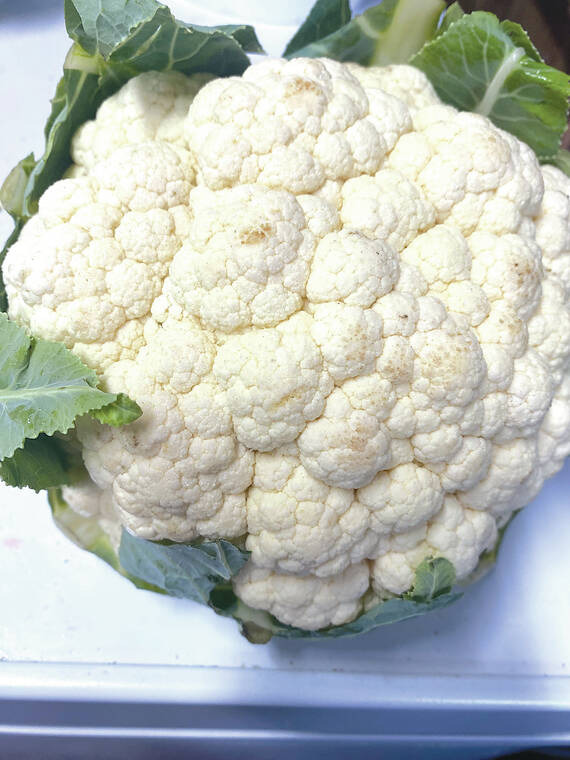Let’s Talk Food: The ubiquitous cauliflower

The ubiquitous cauliflower. (Courtesy photo/Audrey Wilson)
Poor cauliflower! It is a vegetable that did not get much attention until someone decided to mince it and call it cauliflower rice. It always seemed to be a stepchild, some calling it ubiquitous as it is ever present but it doesn’t get much attention.
Poor cauliflower! It is a vegetable that did not get much attention until someone decided to mince it and call it cauliflower rice. It always seemed to be a stepchild, some calling it ubiquitous as it is ever present but it doesn’t get much attention.
In actuality, cauliflower is a very nutritious vegetable with 2 grams of dietary fiber, vitamin C, vitamin K, vitamin B6, folate, pantothenic acid, potassium, manganese, choline, magnesium and phosphorous. It is also a good source of antioxidants like other cruciferous vegetables such as kale and cabbage. Cauliflower is high in glucosinolates and isothiocyanates, two groups of antioxidants that, according to Healthline, “have been shown to slow the growth of cancer cells.”
ADVERTISING
It also contains carotenoid and flavonoid antioxidants, which Healthline claims “have anti-cancer effects and may reduce the risk of several other illnesses, including heart disease.”
Cauliflower may aid in weight loss as it is low in calories, only 27 calories per cup, and therefore the popularity of cauliflower rice.
There is a high water content in cauliflower as 92 percent of its total weight is water.
Choline, mentioned above as one of the nutrients in cauliflower, has great health benefits in maintaining the integrity of cell membranes, brain development and the production of neurotransmitters. Animal studies have shown that choline deficiency may increase the risk of liver disease and neurological disorders like Alzheimer’s disease.
Rich in sulforaphane, test-tube and animal studies, according to Healthline, “found sulforaphane to be particularly helpful for suppressing cancer development by inhibiting enzymes that are involved in cancer and tumor growth.” Further, studies show that cauliflower may help reduce high blood pressure and keep our arteries healthy. Animal studies suggest that sulforaphane may also help fight diabetes.
So now you know why your parents said to eat your vegetables. I believe that food is medicine with so many nutrients.
In cooking, cauliflower has a mild flavor and is the perfect canvas for many dishes. In other words, it is a princess, and in a dish would let the bully taste shine out. You can now find cauliflower flour that is used to make pizza crust, tortillas and even cauliflower mac and cheese.
Here is the New York Times Cooking cauliflower “mac” and cheese recipe:
Cauliflower “Mac” and Cheese
Serves 4 to 6
1 large cauliflower (2-1/2 pounds), cut into small florets the size of macaroni
3 tablespoons extra-virgin olive oil
Kosher salt and black pepper
1-1/2 cups grated cheddar cheese (6 ounces)
1 cup heavy cream
1 clove garlic, finely grated
1/4 teaspoon cayenne
Heat the oven to 450 degrees.
Toss the cauliflower with the olive oil on a baking sheet.
Season with salt and pepper, spread in an even layer and roast until browned and cooked through but retaining some bite, about 15 minutes.
Transfer the cauliflower to an 8-inch or other 2-quart baking dish. (You could also bake this in individual ramekins; just mix the cauliflower with the other ingredients in a medium bowl before dividing.)
Reserve 1/4 cup cheddar cheese.
Add the remaining 1-1/4 cups cheese, heavy cream, garlic and cayenne to the cauliflower and stir to combine. Season with salt and pepper, then top with the reserved 1/4 cup cheddar.
Roast until the cream has thickened, the cheese has melted, and some of the cauliflower is browned on top, 15 to 20 minutes. Let sit for 5 minutes before serving.
In the recent issue of Cook’s Country, this interesting cauliflower salad with dates intrigued me and is a keeper.
Shaved Cauliflower Salad with Date-Dijon Dressing
Serves 6
1 head cauliflower (2 pounds )
2 ounces pitted Medjool dates, coarsely chopped (1/3 cup)
1/4 cup extra-virgin olive oil
1/4 cup white wine vinegar
2 tablespoons Dijon mustard
2 tablespoons water
1 garlic clove, smashed and peeled
1 teaspoon table salt
1/2 teaspoon black pepper
2 celery ribs, sliced on the bias, plus 1/2 cup celery leaves
1/2 cup chopped fresh parsley
2 tablespoons chopped fresh tarragon
2 ounces Pecorino Romano cheese, shaved with a vegetable peeler
1/2 cup shelled pistachios, toasted and chopped
Trim outer leaves of cauliflower and cut stem flush with bottom of heat. Place cauliflower stem side up on a cutting board. Cut stems around the core to remove a large (2-3 inch) florets.
Slice each floret lengthwise as thin as possible (about 1/8 inch thick). Slice core crosswise as thin as possible. (You should have about 6-1/2 cups thinly sliced cauliflower.)
Transfer to a large bowl.
Process dates, oil, vinegar, mustard, water, garlic, salt and pepper in a blender until mostly smooth with some finely chopped dates remaining, about 1 minute, scraping down sides of blender jar as needed. Transfer dressing to a bowl with cauliflower.
Add celery ribs and leaves, parsley and tarragon to the cauliflower mixture and toss gently to combine.
Refrigerate until cauliflower is slightly softened, at least 30 minutes. (Cauliflower mixture can be refrigerated for up to 12 hours.)
Fold Pecorino and pistachios into cauliflower mixture. Season with salt and pepper to taste.
Transfer salad to platter and serve.
Foodie bites
Hawaii Community College’s Culinary Program’s Cafeteria and da ‘Ohana Corner Cafe is open. Check out the http://hawaii.hawaii.edu/cafeteria or call 808-934-2559 for the Cafeteria or 808-934-2591 for the Corner Cafe.
Email Audrey Wilson at audreywilson808@gmail.com.


